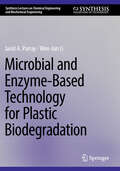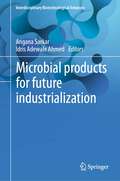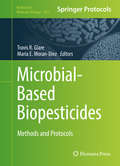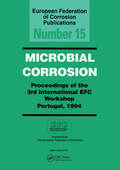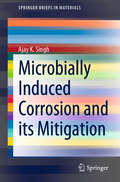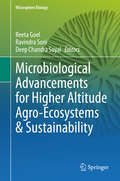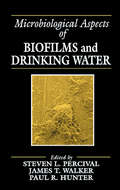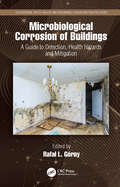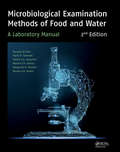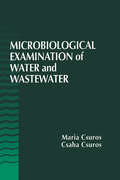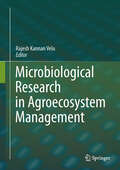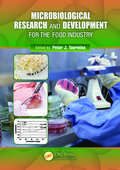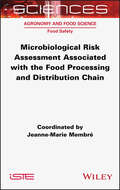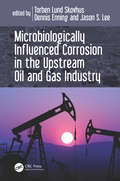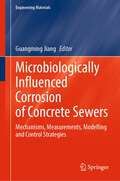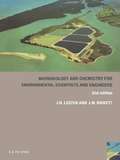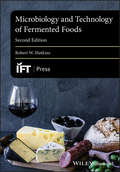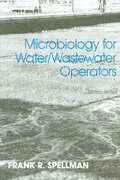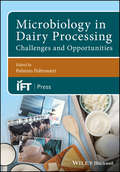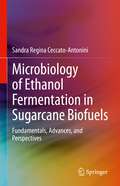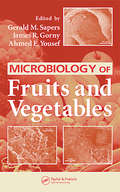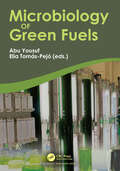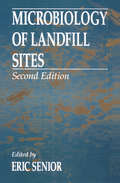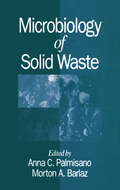- Table View
- List View
Microbial and Enzyme-Based Technology for Plastic Biodegradation (Synthesis Lectures on Chemical Engineering and Biochemical Engineering)
by Javid Ahmad Parray Wen-Jun LiImproper disposal of plastics increases micro-plastic discharge and waste to the environment. It causes growing global concern about the environmental and public health impacts of related byproducts. This book presents a safe process based on application of microbial cultures from different sources for the degradation of plastic waste to harmless products. The book begins by introducing the problem of plastic waste and its environmental impact, then moves on to describing microbial resources and the mechanism of biodegradation before presenting examples of biodegradation processes. Challenges of the microbial and enzyme based technologies for plastic biodegradation and potential research directions are also discussed.
Microbial products for future industrialization (Interdisciplinary Biotechnological Advances)
by Angana Sarkar Idris Adewale AhmedThis book “Microbial Products for Future Industrialization” focuses on the exploitation of various advanced microbial and molecular biology technologies and their associated processes, especially the microbial-molecular-chemical nexus, for the future industrialization of emerging new microbial products. The descriptions given in its chapters take the reader through an entire journey of new emerging microbial products from lab to industry and provide new information that has not yet been fully exploited for future industrialization steps. This volume is a great resource for readers seeking a more comprehensive material covering the technical, economic, and societal aspects that impact bioprocessing of microbial products at the industrial level along with biotechnological intervention for better production of microbial products in near future. This book also encompasses advanced and updated information as well as future directions for young researchers and scientists, and academics who are working in the field of microbial product production related to sustainability.
Microbial-Based Biopesticides
by Travis R. Glare Maria E. Moran-Diez"This volume focuses on the developmental areas of biopesticides: production, formulation, application and field efficacy. Chapters guide readers through methods and techniques on environmental, mammalian, safety, and registration. Written in the highly successful Methods in Molecular Biology series format, chapters include introductions to their respective topics, lists of the necessary materials and reagents, step-by-step, readily reproducible laboratory protocols, and tips on troubleshooting and avoiding known pitfalls. Authoritative and cutting-edge, Microbial-Based Biopesticides aims to ensure successful results in the further study of this vital field. "--
Microbially Corrosion: 3rd International Workshop : Papers (European Federation Of Corrosion Publications)
by C.A.C. Sequeira A.K. TillerFirst published in 1995. This is the proceedings of the third international workshop on Microbial Corrosion by the European Federation of Corrosion. Split into four sections covering an Interdisciplinary Approach to Microbially Influenced Corrosion of Copper; Microbial Corrosion: Mechanisms and General Studies; Case Studies, and Microbial Corrosion: Prevention and Control.
Microbially Induced Corrosion and its Mitigation (SpringerBriefs in Materials)
by Ajay K. SinghThis brief covers case studies on Microbial Induced Corrosion (MIC) and its mitigation. After reviewing the basics of corrosion, it focuses on MIC. MIC is a special type of electrochemical corrosion in which the presence of microbes and bacteria alters the chemistry of liquid media so as to make them more corrosive. These changes are harmful to metallic equipment, processing machinery, marine vessels, etc. in an environment that is host to a wealth of microorganisms. A 2007 US survey estimated corrosion-related damages to cost $276 billion a year, roughly 50% of which are due to MIC. The industries most affected by MIC are power production, oil exploration, transportation and storage, water distribution and more generally all industries involving marine environments. However, means for effectively preventing and controlling MIC are poorly understood. As such, the book’s later chapters address various mechanisms/processes that show promise with regard to MIC mitigation. Lastly, the book discusses the strategies currently being explored to mitigate MIC using green technologies.
Microbiological Advancements for Higher Altitude Agro-Ecosystems & Sustainability (Rhizosphere Biology)
by Reeta Goel Ravindra Soni Deep Chandra SuyalThe book explores the challenges and opportunities associated with high-altitude agro-ecosystems and the factors that influence them. It discusses the various indigenous agricultural practices and approaches, as well as the microbiology of mountain & hill agro-ecosystems, providing a comprehensive overview of the various factors that control the microbiome at high altitudes.The contributions examine microbiological advances, such as use of “omics” technologies for hill agriculture and environmental sustainability, and explore the use of nanotechnology for agricultural and environmental sustainability at higher altitudes. The book also describes various aspects of low-temperature microbiology in the context of high-altitude farming and environmental sustainability.
Microbiological Aspects of Biofilms and Drinking Water
by Steven Lane Percival James Taggari Walker Paul R. HunterThe development of biofilms and their role in public health - particularly drinking water - is often overlooked. Ideal for anyone interested in water related issues, Microbiological Aspects of Biofilms and Drinking Water presents an overview of the public health effects associated with drinking water. It highlights the microbiological aspects relat
Microbiological Corrosion of Buildings: A Guide to Detection, Health Hazards, and Mitigation (Occupational Safety, Health, and Ergonomics)
by Rafał L. GórnyEnvironmental stress caused by water continuously exposes buildings to microbial colonization. This is highly evident when both minor dampness and mass flooding occur. The text describes how microbiological corrosion of buildings and the structures and substances derived from these hazards are responsible for adverse health effects on people exposed to these contaminated environments. Microbiological Corrosion of Buildings: A Guide to Detection, Health Hazards, and Mitigation describes the key elements and methods for neutralising and removing microbiological contamination, and the operating algorithm for checking the effectiveness of preventative solutions. Ideal for construction engineers, microbiologists and professionals in the field. Features: Latest methods for detection of indoor microbial hazards Identifies the tools needed for natural, non-destructive and non-invasive methods of bio-corrosion removal Describes the social and health problems associated with exposure to microbiological hazards Provides case studies and examples of microorganisms responsible for microbial corrosion. ‘Climate change and the associated adverse effects, such as floods and whirlwinds, make the problem of microbiological corrosion of buildings that generates health risks and economic losses on a global scale, the focus of science and technology. The monograph presents a complex problem of building bio-corrosion, that requires knowledge of the distant fields of microbiology and building technology, for the use of both scientists and practitioners. This pioneering work of an interdisciplinary nature harmoniously combines knowledge on specific microbiological issues relating to the process of bio-corrosion and the associated health risks with detailed issues of construction technology concerning the prevention of bio-corrosion and its removal. The authors succeeded in combining a very high scientific level in the monograph with an accessible and understandable presentation of complex problems. The extensive references, ranging from "classical" items from many years ago to the most recent articles presenting the state of the art in this field, are worth emphasising.’ —Prof. Jacek Dutkiewicz, Ph.D., D.Sc., Institute of Rural Health in Lublin
Microbiological Examination Methods of Food and Water: A Laboratory Manual, 2nd Edition
by Neusely da Silva Marta H. Taniwaki Valéria C.A. Junqueira Neliane Silveira Margarete Midori Okazaki Renato Abeilar Romeiro GomesMicrobiological Examination Methods of Food and Water (2nd edition) is an illustrated laboratory manual that provides an overview of current standard microbiological culture methods for the examination of food and water, adhered to by renowned international organizations, such as ISO, AOAC, APHA, FDA and FSIS/USDA. It includes methods for the enumeration of indicator microorganisms of general contamination, indicators of hygiene and sanitary conditions, sporeforming, spoilage fungi and pathogenic bacteria. Every chapter begins with a comprehensive, in-depth and updated bibliographic reference on the microorganism(s) dealt with in that particular section of the book. The latest facts on the taxonomic position of each group, genus or species are given, as well as clear guidelines on how to deal with changes in nomenclature on the internet. All chapters provide schematic comparisons between the methods presented, highlighting the main differences and similarities. This allows the user to choose the method that best meets his/her needs. Moreover, each chapter lists validated alternative quick methods, which, though not described in the book, may and can be used for the analysis of the microorganism(s) dealt with in that particular chapter. The didactic setup and the visualization of procedures in step-by-step schemes allow the user to quickly perceive and execute the procedure intended. Support material such as drawings, procedure schemes and laboratory sheets are available for downloading and customization. This compendium will serve as an up-to-date practical companion for laboratory professionals, technicians and research scientists, instructors, teachers and food and water analysts. Alimentary engineering, chemistry, biotechnology and biology (under)graduate students specializing in food sciences will also find the book beneficial. It is furthermore suited for use as a practical/laboratory manual for graduate courses in Food Engineering and Food Microbiology.
Microbiological Examination of Water and Wastewater
by Maria CsurosMicrobiological tests have proven to be an indispensable part of environmental contaminant detection. It has also been tremendously difficult to find a comprehensive training manual and laboratory manual for those procedures.Microbiological Examination of Water and Wastewater now provides that much-needed resource for laboratory trainees and environmental professionals alike.An all-inclusive guide to applications and techniques of microbiological testing, Microbiological Examination of Water and Wastewater includes coverage of General Microbiology, Environmental Microbiology, Environmental Microbiology Laboratory, plus Techniques and Methods in Routine Environmental Microbiology Laboratory.By exploring the fundamentals of microbiology, as well as microbial metabolism, growth, control, and classification, trainees will better understand the purpose and manner of microbiological examination. Those details also make Microbiological Examination of Water and Wastewater ideal as a standard guidebook for laboratories, water and wastewater treatment plants, and the communities they serve.
Microbiological Research In Agroecosystem Management
by Rajesh Kannan VeluAgroecosystem is an ideal dynamic functional system with a set of chemical and biological interaction taking place in plant surface either below or above the ground levels. These levels of interaction activities fundamentally with microorganism-plant-soil systems are extended upto the level of entire agricultural economy. Greatly simplified, the agroecosystems control the various range of energy flux, resources exchange, organic and inorganic nutrient budgets and population dynamics. The main aim of this edited volume is to provide a broad spectrum of agroecosystems structure, function and maintenance involved in microbial research. This book consists of 20 full length research articles focusing on the emerging problems in the field and the positive findings are identified on key areas of research such as biodiversity, ecosystem service, environmental cleaning in agroecology, etc. These articles are arranged progressively linking themselves thematically with photographs, figures and tables. Focused field articles are included which prove a valuable contribution to the field of agroecosystem management by microbial facilitations. The editor hopes that these articles would prompt the budding scholars to further their research which in turn would certainly help the agriculturists.
Microbiological Research and Development for the Food Industry
by Peter J. TaorminaResearch and development on microorganisms in food has evolved from a luxury to a necessity for companies competing in the global marketplace. Whether research is conducted internally or externally through contract laboratories and universities, microbial research in foods is crucial to the safety and integrity of our food supply. Microbiological R
Microbiological Risk Assessment Associated with the Food Processing and Distribution Chain
by Jeanne-Marie MembreAccording to the World Health Organization, one in every ten people worldwide falls ill from eating contaminated food every year, with 550 million cases of diarrheal diseases. Microbiological risk assessment aims to characterize the nature and probability of harm resulting from human exposure to the biological agents that are present in foodstuffs. This assessment must take into account all stages of the chain: from the production of raw materials to consumption. After briefly introducing food safety and risk assessment, this book details the four major steps of microbiological risk assessment. The contributors first present hazard identification and then exposure assessment, which is subdivided into methods for the detection and enumeration of pathogens and for the quantification of the level of exposure. Then, hazard characterization is subdivided into pathogenicity mechanisms and quantification of the dose–response relationship. Finally a guide for microbiological risk characterization is provided. The conclusion presents possible development avenues for microbiological risk assessment, particularly its integration into a holistic assessment of food systems.
Microbiologically Influenced Corrosion in the Upstream Oil and Gas Industry
by Torben Lund Skovhus Dennis Enning Jason S. LeeMicroorganisms are ubiquitously present in petroleum reservoirs and the facilities that produce them. Pipelines, vessels, and other equipment used in upstream oil and gas operations provide a vast and predominantly anoxic environment for microorganisms to thrive. The biggest technical challenge resulting from microbial activity in these engineered environments is the impact on materials integrity. Oilfield microorganisms can affect materials integrity profoundly through a multitude of elusive (bio)chemical mechanisms, collectively referred to as microbiologically influenced corrosion (MIC). MIC is estimated to account for 20 to 30% of all corrosion-related costs in the oil and gas industry. This book is intended as a comprehensive reference for integrity engineers, production chemists, oilfield microbiologists, and scientists working in the field of petroleum microbiology or corrosion. Exhaustively researched by leaders from both industry and academia, this book discusses the latest technological and scientific advances as well as relevant case studies to convey to readers an understanding of MIC and its effective management.
Microbiologically Influenced Corrosion of Concrete Sewers: Mechanisms, Measurements, Modelling and Control Strategies (Engineering Materials)
by Guangming JiangThis book is a unique resource for professionals seeking a comprehensive understanding of microbiologically influenced corrosion in concrete sewers (MICC), which play a critical role in modern urban infrastructure. Corrosion can lead to structural collapse and significant financial losses due to the costly rehabilitation and replacement of damaged sewer systems. In the United States alone, sewer asset losses attributed to corrosion are estimated to reach $14 billion annually.The book provides a cross-disciplinary approach to understanding the physical, chemical, and biological processes that contribute to microbiologically influenced concrete corrosion. Readers will learn about corrosion rate measurement and characterization methods, controlling environmental factors, corrosion prediction models, and mitigation and control strategies. The book also covers the development of corrosion-resistant concrete. Written for civil engineers, environmental engineers, concrete technologists, and sewer operators and managers, this book is both informative and practical. It not only provides fundamental knowledge of the development of corrosion but also offers practical solutions that are economically and environmentally sustainable. By collating a range of corrosion analytics and control measures, this book is an essential reference for anyone seeking to prevent and manage concrete corrosion in sewer systems.
Microbiology and Chemistry for Environmental Scientists and Engineers
by John Lester Jason BirkettBiological and chemical processes play a key role in the treatment of domestic wastewater and are becoming increasingly important in tackling the problems caused by industrial wastes. The first edition of this popular text focused on microbial systems and wastewater processes that are implemented in a treatment plant. While maintaining this approac
Microbiology and Technology of Fermented Foods (Institute of Food Technologists Series #32)
by Robert W. HutkinsThe revised and expanded text on food fermentation microbiology With this second edition of Microbiology and Technology of Fermented Foods, Robert Hutkins brings fresh perspectives and updated content to his exhaustive and engaging text on food fermentations. The text covers all major fermented foods, devoting chapters to fermented dairy, meat, and vegetable products, as well breads, beers, wines, vinegars, and soy foods. These insights are enhanced by detailed explanations of the microbiological and biochemical processes that underpin fermentation, while an account of its fascinating history provides readers with richly contextualizing background knowledge. New to this edition are two additional chapters. One discusses the role that fermentation plays in the production of spirits and other distilled beverages, whereas another focuses on cocoa, coffee, and fermented cereal products. Furthermore, key chapters on microorganisms and metabolism have been expanded and elaborated upon, and are complemented by other relevant revisions and additions made throughout the book, ensuring that it is as up-to-date and applicable as possible. This essential text includes: Discussions of major fermented foods from across the globe Background information on the science and history behind food fermentation Information on relevant industrial processes, technologies, and scientific discoveries Two new chapters covering distilled spirits and cocoa, coffee, and cereal products Expanded chapters on microorganisms and metabolism Microbiology and Technology of Fermented Foods, Second Edition is a definitive reference tool that will be of great interest and use to industry professionals, academics, established or aspiring food scientists, and anyone else working with fermented foods.
Microbiology for Water and Wastewater Operators (Revised Reprint)
by Frank R. SpellmanThis new edition of Microbiology for Water and Wastewater Operators emphasizes the new world order of water control based on microbiological principles and practices. The book explores microbes that threaten health and links microbes to operator activities and collection procedures. It provides need-to-know information about microbiology fundamentals and applications. This resource serves as a basic study tool by water/wastewater personnel preparing for their licensing examinations, or as a supplemental text in undergraduate or graduate courses in aquatic ecology, water/wastewater pollution control and in environmental science courses dealing with water biology.
Microbiology in Civil Engineering: Proceedings of the Federation of European Microbiological Societies Symposium held at Cranfield Institute of Technology, UK
by P. HowsamAlthough most public health and environmental engineers are aware of the importance of microbial activity, many civil engineers do not appreciate the part microbiological process play in, for example, biodeterioration of concrete and other construction materials, alteration of soil and rock properties, clogging of boreholes, distribution and irriga
Microbiology in Dairy Processing: Challenges and Opportunities
by Palmiro PoltronieriAn authoritative guide to microbiological solutions to common challenges encountered in the industrial processing of milk and the production of milk products Microbiology in Dairy Processing offers a comprehensive introduction to the most current knowledge and research in dairy technologies and lactic acid bacteria (LAB) and dairy associated species in the fermentation of dairy products. The text deals with the industrial processing of milk, the problems solved in the industry, and those still affecting the processes. The authors explore culture methods and species selective growth media, to grow, separate, and characterize LAB and dairy associated species, molecular methods for species identification and strains characterization, Next Generation Sequencing for genome characterization, comparative genomics, phenotyping, and current applications in dairy and non-dairy productions. In addition, Microbiology in Dairy Processing covers the Lactic Acid Bacteria and dairy associated species (the beneficial microorganisms used in food fermentation processes): culture methods, phenotyping, and proven applications in dairy and non-dairy productions. The text also reviews the potential future exploitation of the culture of novel strains with useful traits such as probiotics, fermentation of sugars, metabolites produced, bacteriocins. This important resource: Offers solutions both established and novel to the numerous challenges commonly encountered in the industrial processing of milk and the production of milk products Takes a highly practical approach, tackling the problems faced in the workplace by dairy technologists Covers the whole chain of dairy processing from milk collection and storage though processing and the production of various cheese types Written for laboratory technicians and researchers, students learning the protocols for LAB isolation and characterisation, Microbiology in Dairy Processing is the authoritative reference for professionals and students.
Microbiology of Ethanol Fermentation in Sugarcane Biofuels: Fundamentals, Advances, and Perspectives
by Sandra Regina Ceccato-AntoniniThis book discusses the microbiology of fermentation for the production of bioethanol from sugarcane. Coverage includes how selected yeasts improve ethanol yield and productivity concerning recent advances at genomic, transcriptomic, and proteomic levels, how microorganisms (bacteria and yeasts) interact with each other in fermentation vats, and the application of microbiological monitoring methods with safety and precision. Special attention is given to antimicrobial strategies used to decrease contamination. The book is aimed at professionals working in the bioethanol industry, as well as students and researchers studying biological and biotechnological aspects of applied matters such as industrial microbiology and industrial fermentations. The English translation of this book from its Portuguese original manuscript was done with the help of artificial intelligence (machine translation by the service provider DeepL.com). A subsequent human revision of the content was done by the author. Covers common microbiological monitoring techniques;Reviews selected yeasts used in the bioethanol industry;Examines the role of bacteria and native yeasts in ethanolic fermentation and methods to control their growth.
Microbiology of Fruits and Vegetables
by Ahmed E. Yousef Gerald M. Sapers James R. GornyMicrobiology of Fruits and Vegetables presents a holistic view of the problem of produce contamination that examines both pre-harvest and post-harvest sources and practices. It addresses a number of topical issues relating to the microbiological quality and safety of fresh and processed fruits and vegetables and explores the linkage between microbial attachment, the state of microbial contaminants on produce surfaces, and the problem of decontamination. This volume focuses on five distinct areas, and within these areas, provides in-depth coverage of scientific issues important to an understanding of the field and technical issues of economic and public health significance.
Microbiology of Green Fuels
by Abu Yousuf Elia Tomás-PejóThe replacement of fossil-derived compounds by bio-based fuels and chemicals is crucial for the implementation of a sustainable bioeconomy. In this context, microorganisms are key players for biofuels’ production from renewable sources. Biotechnological biofuel production processes require conversion microorganisms capable of both efficiently assimilating renewable low-cost carbon sources and diverting their metabolisms towards the specific biofuel. Exploring the wide diversity of microorganisms available on Earth will surely aid to make the production of green fuels a reality. This book gives a wide overview of different microbial-based processes for green fuels production. The book also includes techno-economic analysis and highlights strategic, commercial and environmental interests in promoting green fuels. All these facts make this book very valuable not only for the scientific community but also for biofuel companies and policy makers.
Microbiology of Landfill Sites
by Eric SeniorThis book was originally published in 1990 and was the first text to consider the definitive fundamental science of landfill biotechnology. Since then, major research initiatives, particularly in the U.K. and South Africa, have resulted in considerable advancement in our knowledge of landfill microbiology. The Second Edition details this progress. Text considers the latest findings in landfill leachate treatment, co-disposal and fundamental microbiology. It brings together the expertise of the immediate complementary, but often disparate disciplines of soil science, environmental engineering, applied mathematics, and land reclamation and focuses on the common goal of the scientific design and management of landfill sites. The book also includes effective laboratory models and selected approaches.
Microbiology of Solid Waste (Microbiology Of Extreme And Unusual Environments Ser. #3)
by Morton A. Barlaz Anna C. PalmisanoInterest in solid waste disposal has been growing since the early 1960s, when researchers emphasized the potential for solid waste to harbor pathogenic microorganisms. Since then, society has become more interested in the environmental impacts of solid waste treatment and disposal, and how biological processes are used to minimize these impacts. This new text provides a basic understanding of the unique microbial ecosystems associated with the decomposition of municipal solid waste (MSW). It addresses the challenges of sampling and assaying microbial activities in MSW and describes preferred methods. The decomposition of MSW under anaerobic conditions in landfills and digestors is described, as well as under aerobioconditions during composting.The Microbiology of Solid Wastes discusses the need to consider MSW as an integrated system of collection, recycling, treatment, and disposal. A better understanding of solid waste microbiology will contribute to safe and economical solid waste management. Microbiologists, environmental engineers, and solid waste managers will all find this a useful reference.
